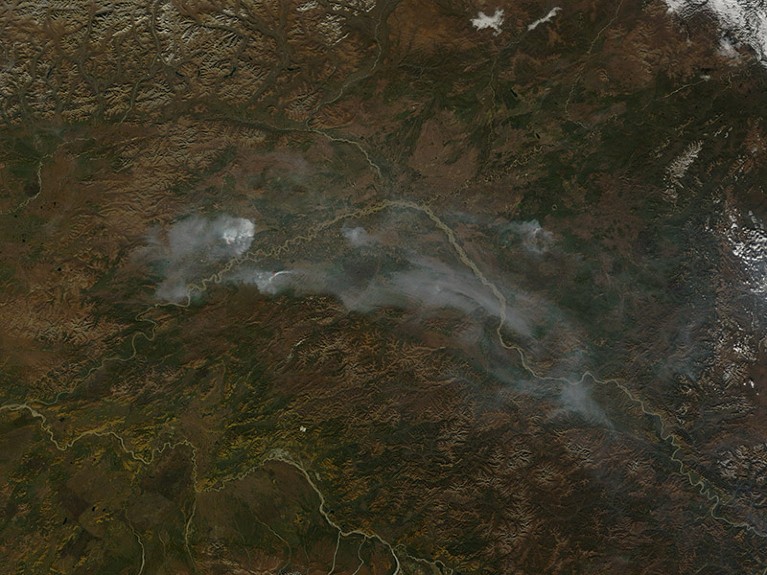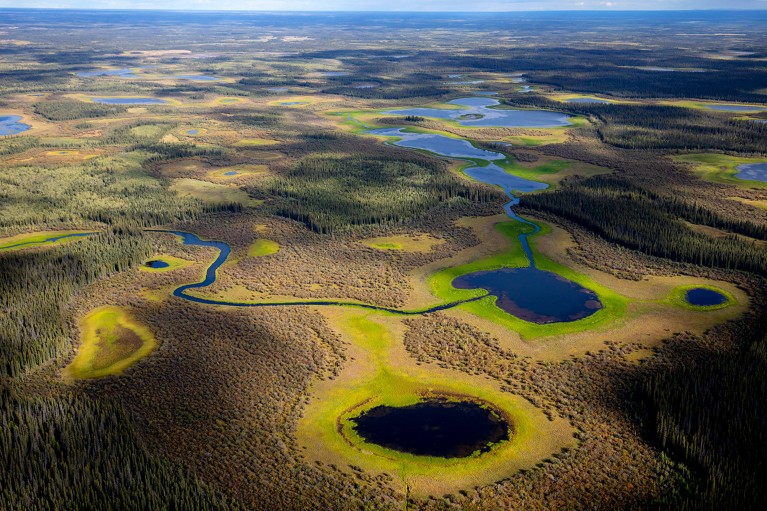Fire season is approaching in the massive Yukon Flats National Wildlife Refuge in east Alaska, where fires have long been allowed to burn unchecked unless they threaten human life and property. But as climate change increases the frequency of these fires, the land’s overseers are changing course. Working with scientists, refuge managers have designed a pilot programme to parachute elite firefighting teams into remote areas to quash infernos — to protect not people, but permafrost.
The forests and tundra of the Denmark-sized refuge cloak a deep layer of permafrost, frozen ground that holds enormous quantities of carbon across the Northern Hemisphere. After fires remove vegetation and soils, however, that frozen ground often begins to thaw, releasing its stores of carbon dioxide and other greenhouse gases into the atmosphere. New research1 suggests that the resulting emissions, from both the fires themselves and the subsequent permafrost thaw, could be on a par with those of a major global economy over the course of this century. This could effectively reduce by up to 20% the amount of carbon dioxide that humanity can emit and still meet its goal of limiting global warming to 1.5 °C above preindustrial levels. The research has not yet been peer reviewed.
These numbers suggest that a rethink of long-standing fire policies in high-latitude boreal forests — where recovery after frequent fires could take decades if it happens at all — might be needed, says Brendan Rogers, an Earth-systems scientist with the Woodwell Climate Research Center in Falmouth, Massachusetts. The pilot programme at Yukon Flats represents a test of that idea in an area where permafrost is particularly vulnerable.
“What we’re talking about is aggressive attacks on fires when they ignite in these areas,” Rogers says. Once such fires get going, he adds, it’s often too late. “That carbon is lost.”
Earth ablaze
The proposal to suppress boreal fires to help fight climate change follows years of increasingly frequent and intense conflagrations that have raged across northern forests and Arctic peatlands. According to estimates, the wildfires in Canada’s boreal forests last year released more than three times as much carbon dioxide as the entire country emitted from burning fossil fuels. Officials at Yukon Flats, for example, say that the frequency of major fires on the refuge has quadrupled since 1988.
Why are the Canadian wildfires so bad this year?
A rise in fire frequency can have cascading effects on the ecosystem, and thus carbon, says Xanthe Walker, an ecologist at Northern Arizona University in Flagstaff, who has studied the effect of fires on permafrost. Historically, boreal forests have burnt once every 70–120 years, she says, which gives the black-spruce forest that dominates the ecosystem enough time to regenerate and rebuild carbon in the soil. More-frequent fires can burn ‘legacy’ carbon that has accumulated over centuries2 and can also kill off the black spruce (Picea mariana). That provides an opening for leafy deciduous trees, which do not promote the kind of carbon-rich soils that insulate permafrost.
Emissions win
Fire suppression could help to stave off some of these effects, buying humanity time to address the climate crisis. In a 2022 paper3, researchers at Woodwell and the Union of Concerned Scientists, a non-profit organization in Cambridge, Massachusetts, found that fire-suppression efforts in Alaska tend to reduce the total area burnt. Their calculations suggest that investing in fire suppression could reduce carbon emissions at a lower cost than that of many technologies for reducing industrial emissions. With an investment of around US$700 million annually in suppression over the next decade, Alaska alone could reduce carbon emissions by up to 3.9 billion tonnes of carbon dioxide up to mid-century. That is more than the annual greenhouse-gas emissions of the European Union.

Smoke billows from fires burning in the Yukon Flats National Wildlife Refuge in eastern Alaska.Credit: NASA image courtesy Jeff Schmaltz, MODIS Rapid Response Team at NASA GSFC
The idea that governments can or should attempt fire suppression in remote boreal forests has encountered some scepticism, owing in part to the scale of the challenge. Fires also play an important part in the ecosystem, and research shows that suppression efforts allow fuel to build up in many forests, contributing to increasingly intense fires4.
Still, because of the looming climate crisis, many researchers say that the suppression efforts at the Yukon Flats might be worthwhile. “Stopping fires across the boreal forests is an impossible feat, but targeted suppression in areas that are vulnerable seems like a great strategy,” says Walker.
A refuge for permafrost
The pilot project at Yukon Flats began last year in eight areas covering nearly 650,000 hectares of land. Those zones account for 19% of the refuge and include 40% of the land underlain by a uniquely vulnerable type of permafrost called Yedoma, which contains deep ice wedges that often melt after fires. This causes the land to collapse, exposing ancient carbon to microbes whose activity releases greenhouse gases.
The target areas contain some 1.1 billion tonnes of carbon, which, if released, would be equivalent to around seven years of emissions from US coal burning.
Indigenous youth must be at the forefront of climate diplomacy
Yukon Flats refuge manager Jimmy Fox says that he decided to move forward with the project after consulting with scientists and firefighters. He also involved Indigenous communities that own some 1.2 million hectares of land in the refuge in the discussion. These communities have voiced concerns about wildfire smoke and the negative effects of the fires on water quality and on the land used for hunting, berry picking and other subsistence activities.
Under the pilot programme, firefighters will be deployed on fires that start early in the season and have the potential to burn for several months. Firefighters will engage only if they determine that they can put out the fires within three days, so as to minimize costs and the use of firefighting resources.
Fox notes that Yedoma permafrost zones that burnt decades ago and then collapsed are slowly beginning to recover as vegetation thickens and produces carbon-rich soils that once again insulate the ice below. But with rising temperatures and increasing fire frequency, he says, the danger is that these areas will reach a tipping point at which point recovery would no longer be possible.
Ultimately, the goal is to hold fires to a more historical level. It could be a few decades before scientists can determine whether the effort pays off, Fox warns, “but we have to try”.


 How microbes in permafrost could trigger a massive carbon bomb
How microbes in permafrost could trigger a massive carbon bomb
 How record wildfires are harming human health
How record wildfires are harming human health
 Permafrost collapse is accelerating carbon release
Permafrost collapse is accelerating carbon release



